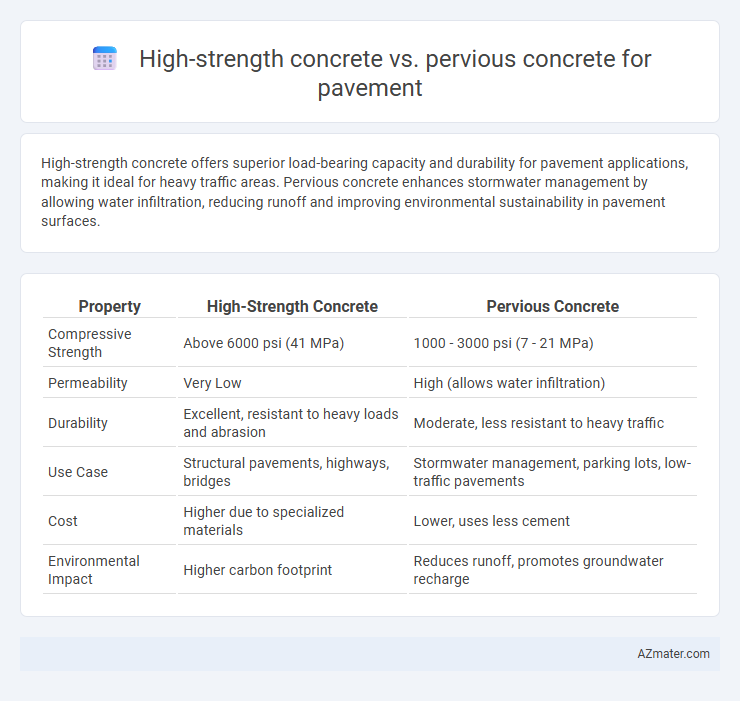High-strength concrete offers superior load-bearing capacity and durability for pavement applications, making it ideal for heavy traffic areas. Pervious concrete enhances stormwater management by allowing water infiltration, reducing runoff and improving environmental sustainability in pavement surfaces.
Table of Comparison
| Property | High-Strength Concrete | Pervious Concrete |
|---|---|---|
| Compressive Strength | Above 6000 psi (41 MPa) | 1000 - 3000 psi (7 - 21 MPa) |
| Permeability | Very Low | High (allows water infiltration) |
| Durability | Excellent, resistant to heavy loads and abrasion | Moderate, less resistant to heavy traffic |
| Use Case | Structural pavements, highways, bridges | Stormwater management, parking lots, low-traffic pavements |
| Cost | Higher due to specialized materials | Lower, uses less cement |
| Environmental Impact | Higher carbon footprint | Reduces runoff, promotes groundwater recharge |
Introduction to Pavement Concrete Types
High-strength concrete is designed with a compressive strength typically above 6,000 psi, providing exceptional durability and load-bearing capacity ideal for heavy-traffic pavements and industrial applications. Pervious concrete features interconnected voids that allow water to permeate through the pavement, significantly reducing surface runoff and promoting groundwater recharge in urban areas. Selecting the appropriate pavement concrete type depends on the specific performance requirements, environmental impact considerations, and structural demands of the project site.
High-Strength Concrete: Composition and Properties
High-strength concrete for pavement typically consists of a low water-to-cement ratio, high cement content, and the incorporation of supplementary cementitious materials such as silica fume or fly ash to enhance durability and compressive strength, often exceeding 6,000 psi. Its dense microstructure provides excellent resistance to heavy loads, abrasion, and environmental degradation, making it ideal for high-traffic areas requiring long service life. By optimizing aggregate gradation and utilizing chemical admixtures like superplasticizers, high-strength concrete achieves superior workability and structural performance compared to traditional mixes.
Pervious Concrete: Composition and Properties
Pervious concrete consists of a mixture of cement, coarse aggregates, water, and minimal or no fine aggregates, creating a highly porous structure that allows water to infiltrate through the pavement surface. Its permeability significantly improves stormwater management and reduces runoff, making it ideal for sustainable urban drainage systems. Although it has lower compressive strength than high-strength concrete, pervious concrete exhibits sufficient durability for pedestrian and light vehicular pavements while promoting groundwater recharge.
Performance in Load-Bearing Applications
High-strength concrete offers superior compressive strength, making it ideal for load-bearing pavement applications requiring durability under heavy traffic and significant structural loads. Pervious concrete, while enhancing stormwater management and reducing runoff, typically exhibits lower compressive strength and may not perform as well under heavy load conditions. Selecting high-strength concrete ensures better resistance to deformation and longer service life in critical infrastructure projects demanding high load-bearing capacity.
Durability and Longevity Comparison
High-strength concrete offers superior durability for pavement due to its dense matrix and high compressive strength, resisting wear, abrasion, and heavy traffic loads effectively over time. Pervious concrete enhances longevity by facilitating water drainage, reducing hydrostatic pressure and freeze-thaw damage, which helps prevent cracking and surface deterioration. While high-strength concrete excels in structural integrity, pervious concrete's permeability significantly extends pavement lifespan in environments prone to moisture-related damage.
Permeability and Drainage Capabilities
Pervious concrete offers superior permeability and drainage capabilities compared to high-strength concrete, allowing water to pass through its porous structure and reducing surface runoff. High-strength concrete, while providing exceptional compressive strength and durability for pavement applications, typically has low permeability, causing water to accumulate on the surface and increasing hydroplaning risks. Choosing pervious concrete enhances stormwater management and reduces the need for additional drainage infrastructure by promoting natural groundwater recharge.
Environmental Impact and Sustainability
High-strength concrete offers enhanced durability and load-bearing capacity, reducing maintenance frequency and resource consumption over pavement lifecycle, thus contributing to sustainability. Pervious concrete significantly improves stormwater management by allowing water infiltration, reducing runoff, and replenishing groundwater, which benefits urban ecosystems and mitigates flooding. While high-strength concrete minimizes material usage through increased performance, pervious concrete supports environmental resilience by promoting natural water cycles and reducing heat island effects.
Cost Analysis: High-Strength vs Pervious Concrete
High-strength concrete for pavement typically involves higher material and production costs due to the use of specialized admixtures and superior aggregates, resulting in increased initial investment. Pervious concrete, while often less expensive to produce, incurs additional maintenance expenses related to clogging and permeability issues that can impact its long-term cost-effectiveness. A comprehensive cost analysis must factor in lifecycle costs, including installation, maintenance, and potential infrastructure savings from improved stormwater management with pervious concrete.
Maintenance and Lifespan Considerations
High-strength concrete offers superior durability and reduced maintenance needs due to its dense matrix and high compressive strength, making it ideal for heavy traffic pavements with long lifespans exceeding 30 years. Pervious concrete, designed for water permeability, requires regular cleaning to prevent clogging and generally has a shorter lifespan around 10-15 years due to its porous structure and susceptibility to freeze-thaw damage. Selecting between these concretes hinges on balancing routine maintenance challenges against expected service life and environmental drainage requirements.
Best Use Cases for Each Concrete Type
High-strength concrete is ideal for pavements subjected to heavy traffic loads and industrial use due to its superior compressive strength and durability. Pervious concrete excels in applications requiring effective stormwater management and reduced runoff, such as parking lots and pedestrian pathways, by allowing water to infiltrate through its porous structure. Choosing the appropriate concrete depends on balancing load-bearing requirements with environmental considerations and permeability needs.

Infographic: High-strength concrete vs Pervious concrete for Pavement
 azmater.com
azmater.com